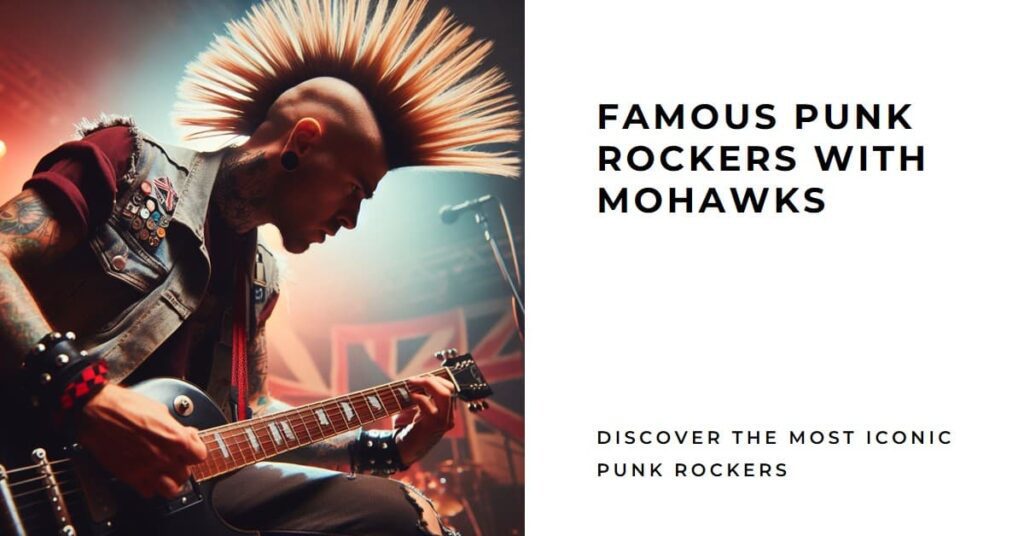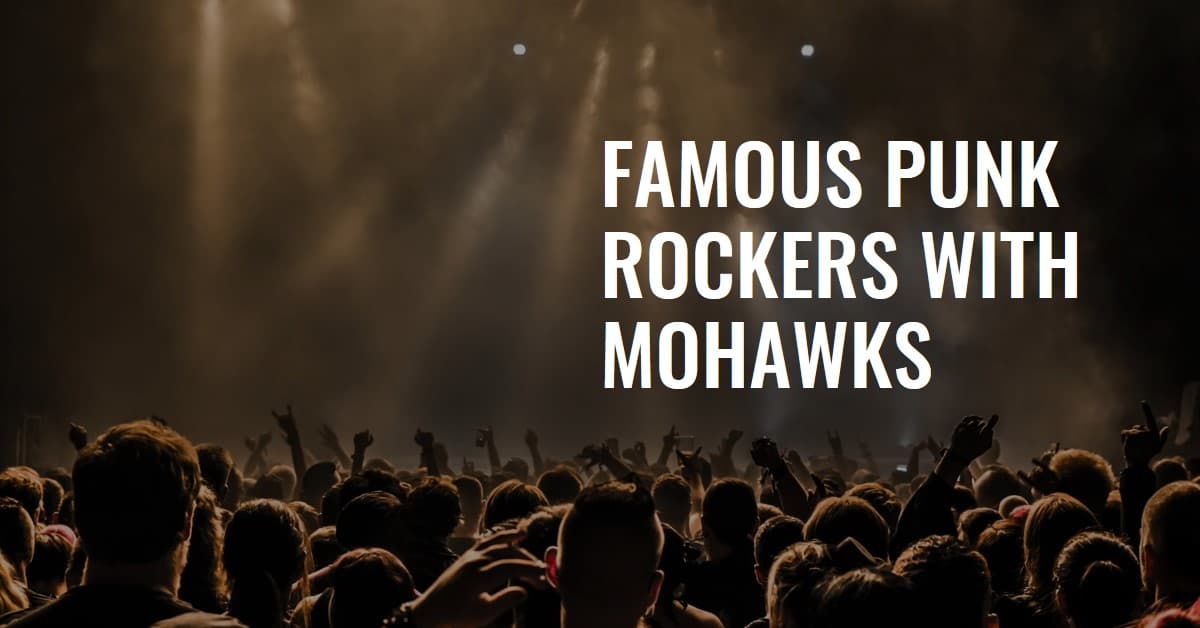I’ll never forget the first time I saw a punk rocker with a towering mohawk strutting down the street, radiating defiance and freedom.
It was like a bolt of lightning, illuminating the raw energy and rebellion of punk culture.
That image stuck with me, a symbol of an unapologetic embrace of individuality and resistance against the mainstream.
Punk rockers with mohawks weren’t just musicians; they were icons of a movement that dared to be different.
In this article, I list the Famous Punk Rockers with Mohawks.
- Top 3 Famous Punk Rockers with Mohawks
- The Origins of the Punk Rock Mohawk
- The Mohawk Evolution in Punk Rock
- Why Did Punk Rockers Adopt the Mohawk Hairstyle?
- Iconic Mohawk Moments in Punk History
- How Has the Mohawk Influenced Fashion and Culture Outside of Punk Rock?
- FAQs on the Famous Punk Rockers with Mohawks
- Conclusion
Top 3 Famous Punk Rockers with Mohawks

These are the top 3 Famous Punk Rockers with Mohawks:
1. Wendy O. Williams – The Queen of Shock Rock
Wendy O. Williams, the lead singer of the Plasmatics, was notorious for her outrageous stage performances and her fierce mohawk. Williams’ mohawk became a symbol of her unapologetic attitude and a visual representation of her boundary-pushing music.
2. Henry Rollins – The Voice of Hardcore Punk
Although Henry Rollins, the frontman of Black Flag, is more often associated with a clean-shaven head, he sported a mohawk during the early days of his career. Rollins’ intense performances and powerful lyrics helped cement his place as a punk rock legend, mohawk or not.
3. Sid Vicious – The Infamous Bassist of the Sex Pistols
Sid Vicious of the Sex Pistols is perhaps one of the most recognizable figures in punk rock history, partly due to his iconic mohawk. Despite his tumultuous life and tragic end, Vicious’ image with a mohawk remains a lasting symbol of punk rock rebellion.
Check out our Punk Aesthetic Outfits to get yourself some good looking punk clothes.
The Origins of the Punk Rock Mohawk
The punk rock mohawk, a symbol of defiance and non-conformity, has its roots deeply embedded in the rebellious soil of the 1970s punk rock movement. This era, marked by social upheaval and a desire to break free from the mainstream, saw the emergence of punk rock as a raw, unfiltered expression of youth discontent and rebellion. The mohawk, with its stark, eye-catching appearance, quickly became synonymous with the punk ethos, embodying the movement’s embrace of individuality and disdain for societal norms.
The adoption of the mohawk by punk rockers was not just a fashion statement but a deliberate act of rebellion. Drawing inspiration from various sources, including the historically significant hairstyles of Native American warriors, punks reappropriated the mohawk to symbolize their own fight against oppression and conformity. It was a visual shock to the conservative sensibilities of the time, representing a bold declaration of autonomy and resistance.
In the streets of London and New York, where punk first exploded, the mohawk became a common sight among the genre’s pioneers and followers alike. Icons like Sid Vicious of the Sex Pistols and Wendy O. Williams of the Plasmatics donned the hairstyle as a badge of honor, further cementing its association with the punk rock movement. The mohawk was more than just hair; it was a flag raised against the status quo, a symbol of a generation determined to make its voice heard.
If you like wearing pink, you shouldn’t miss our Pink Punk Aesthetic Outfits collection.
The Mohawk Evolution in Punk Rock
As punk rock evolved, so did the mohawk, adapting and changing to reflect the genre’s shifting dynamics and the diverse influences that fed into it. From the hardcore scenes of the 1980s to the punk revival of the 1990s and beyond, the mohawk remained a potent symbol of punk identity, though its appearance and significance underwent transformation.
In the hardcore punk scene, the mohawk became bigger, bolder, and more aggressive, mirroring the intensity of the music and the subculture’s more confrontational stance. Variations of the hairstyle, including liberty spikes and dyed versions, emerged, showcasing the creativity and individuality of the punk community. These adaptations kept the spirit of the mohawk alive, allowing it to evolve while maintaining its core significance as a symbol of rebellion.
The 1990s and early 2000s saw a resurgence of interest in punk rock, with a new generation embracing the mohawk as part of their punk identity. This period introduced a fusion of styles, with punk blending with other genres like ska, pop-punk, and emo, each bringing its own twist to the iconic hairstyle. Despite these changes, the mohawk’s association with non-conformity and defiance remained steadfast.
Today, the punk rock mohawk continues to be a powerful emblem of punk culture, cherished by both old-school punks and new adherents alike. Its enduring presence speaks to the lasting impact of the punk movement and its ongoing relevance in a world where the struggle against conformity and oppression remains as vital as ever. The mohawk, in all its forms, remains a vibrant testament to the spirit of punk rock, a visual reminder of the power of individuality and the importance of standing up for one’s beliefs.
Learn how many Punk Aesthetic Types are there and choose which one’s your favorite.
Why Did Punk Rockers Adopt the Mohawk Hairstyle?
Punk rockers adopted the mohawk hairstyle as a symbol of rebellion against societal norms and mainstream culture. The mohawk, with its roots in various indigenous cultures, was embraced by the punk movement to signify non-conformity, defiance, and a break from traditional values. It became a visual representation of the punk ethos and a way to visually distinguish themselves from the rest of society.
Iconic Mohawk Moments in Punk History
These are the most Iconic Mohawk Moments in Punk History:
1. Sid Vicious’s Snarling Performance
Sid Vicious of the Sex Pistols, with his towering, spiked mohawk, became the epitome of punk’s raw, unapologetic spirit. One of the most iconic images of Sid features him snarling into a microphone, mohawk fully on display, during a chaotic live performance. This moment captured the essence of punk: aggressive, confrontational, and fiercely independent.
2. Wendy O. Williams’s Mohawk and Chainsaw
Wendy O. Williams of the Plasmatics took the mohawk to another level, combining her signature hairstyle with outrageous stage antics, including chainsawing guitars in half while performing. Her powerful presence and mohawk became symbols of female empowerment and rebellion in a male-dominated music scene.
3. The Exploited’s Wattie Buchan on Album Covers
Wattie Buchan, lead singer of The Exploited, featured prominently on the band’s album covers with his iconic mohawk. The imagery of these albums, combined with the band’s politically charged lyrics, cemented the mohawk’s association with punk’s anti-establishment message.
4. Henry Rollins’s Intense Performances
While Henry Rollins of Black Flag often sported a shorter, less traditional mohawk, his intense, energetic performances captured the spirit of the hardcore punk scene. Rollins’s physicality and presence on stage, with his hair often standing on end as if in defiance, made a lasting impression on punk and hardcore audiences.
5. The Casualties’ Jorge Herrera’s Liberty Spikes
Jorge Herrera of The Casualties became known for his liberty spikes, a variation of the mohawk that took the hairstyle to new heights—literally. The band’s street punk style and Herrera’s distinctive look became synonymous with the punk scene of the late ’90s and early 2000s, inspiring a new generation of punk fans to adopt the mohawk.
6. Green Day’s Billie Joe Armstrong at Woodstock ’94
Billie Joe Armstrong of Green Day sported a bright green mohawk during the band’s infamous performance at Woodstock ’94. Amidst a mud-slinging melee with the audience, Armstrong’s mohawk became a symbol of punk’s ability to disrupt and engage, even as the genre began to enter the mainstream.
For more inspiration on how to bring the punk spirit into your everyday style, check out our guide on Punk Aesthetic Outfit Ideas.
How Has the Mohawk Influenced Fashion and Culture Outside of Punk Rock?
The mohawk has had a significant influence on fashion and culture beyond the punk rock scene. It has been adopted by various subcultures and movements as a symbol of rebellion and individuality. In fashion, the mohawk has been reinterpreted in various styles, influencing hairstyles and trends across different eras. It has also appeared in mainstream media and entertainment, symbolizing a rebellious spirit or a break from convention.
FAQs on the Famous Punk Rockers with Mohawks
These are the most frequently asked questions on the Famous Punk Rockers with Mohawks:
Are mohawks still popular among punk rockers today?
Yes, mohawks continue to be popular among punk rockers today, serving as a symbol of the punk rock ethos and a nod to the genre’s roots.
Can anyone wear a mohawk, or is it exclusive to the punk rock community?
While the mohawk is closely associated with the punk rock community, it is not exclusive to it. Anyone can wear a mohawk if they choose to.
Conclusion
In wrapping up our journey through the vibrant world of punk rock, it’s clear that the mohawk isn’t just a hairstyle; it’s a powerful symbol of defiance, individuality, and the unyielding spirit of rebellion that defines the genre. Famous punk rockers with mohawks have not only left an indelible mark on music but have also influenced fashion, culture, and the way we think about personal expression. Their legacy continues to inspire new generations to embrace their uniqueness and stand up against conformity. As we’ve seen, the mohawk transcends mere aesthetics, embodying the core values of punk rock and serving as a beacon for those who dare to be different.

